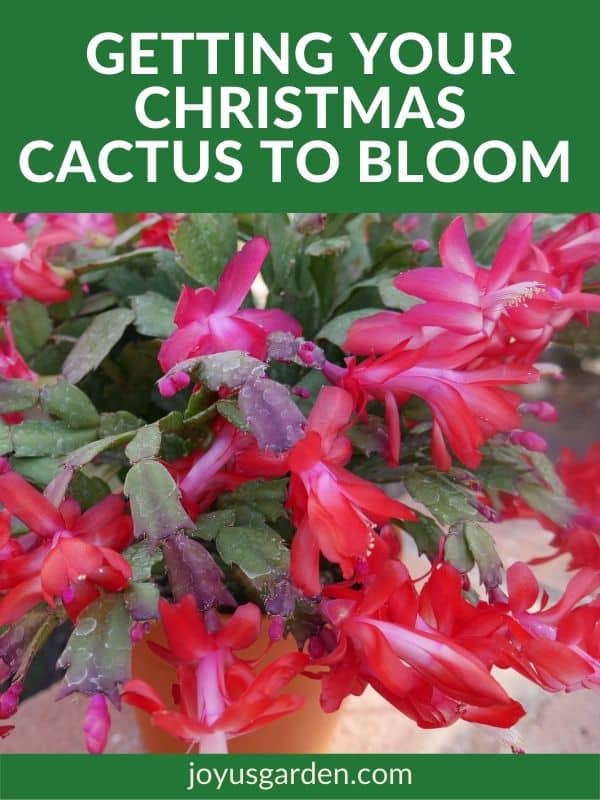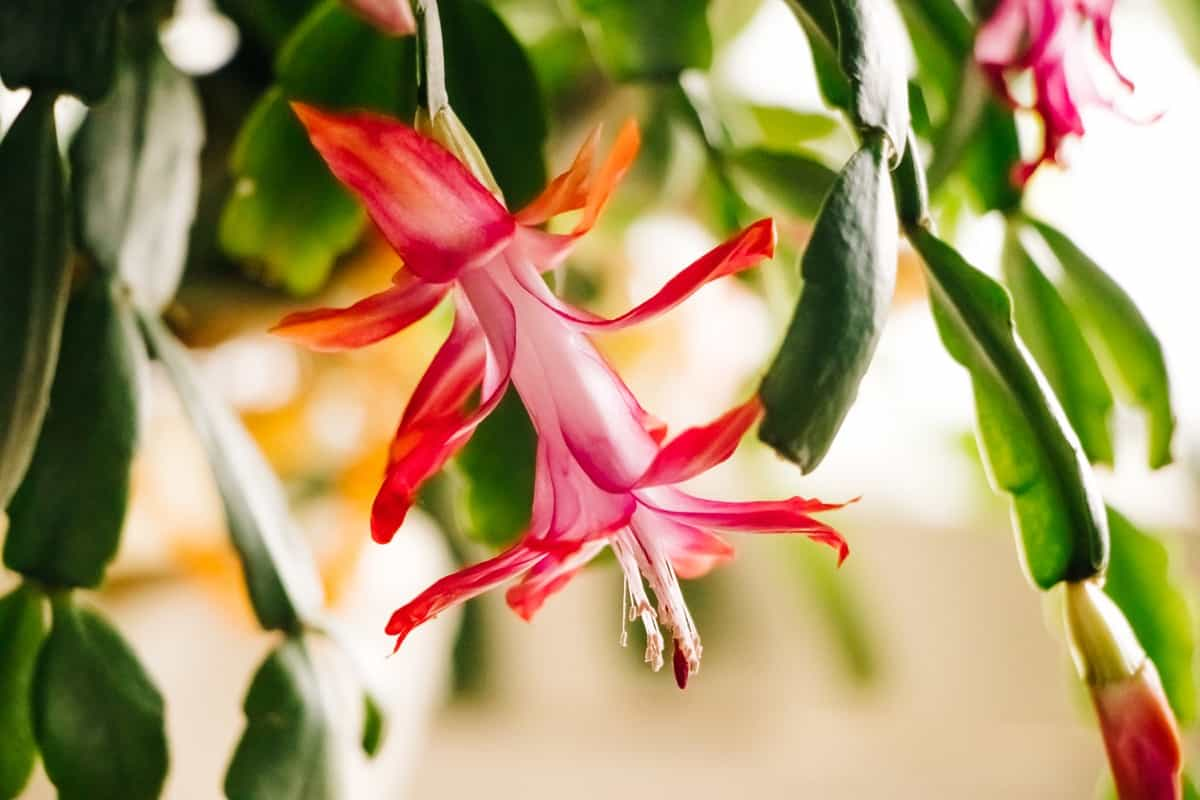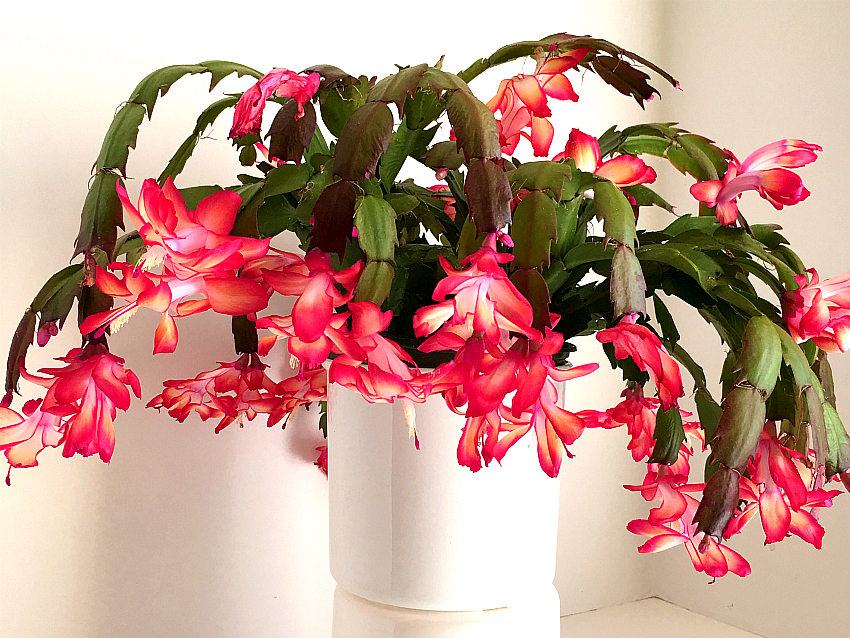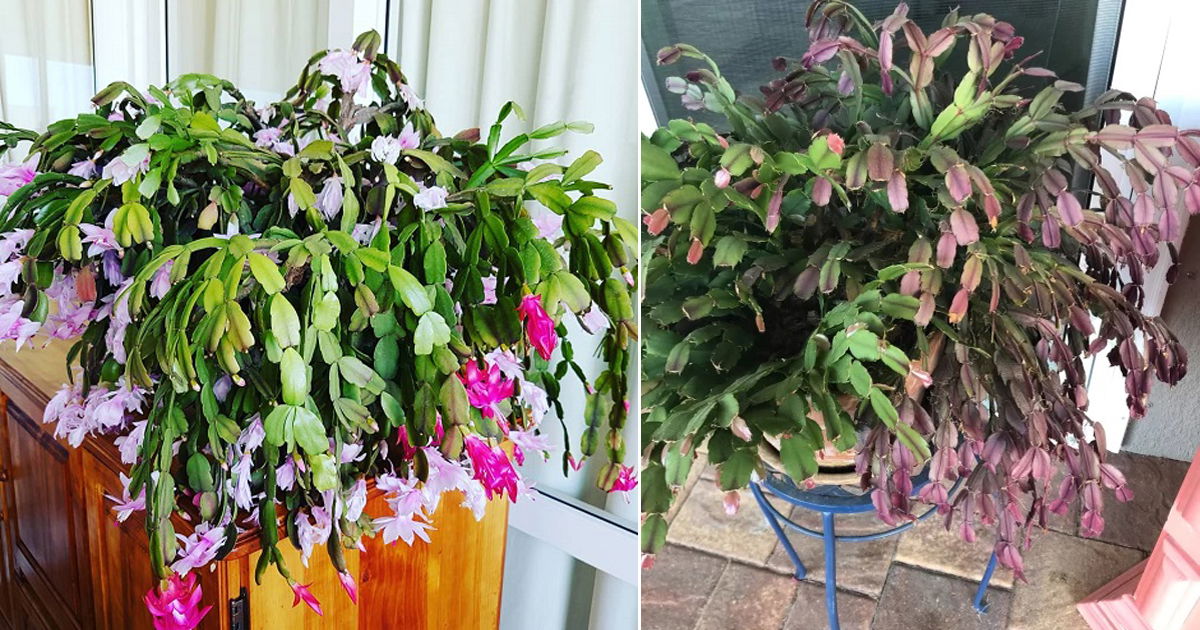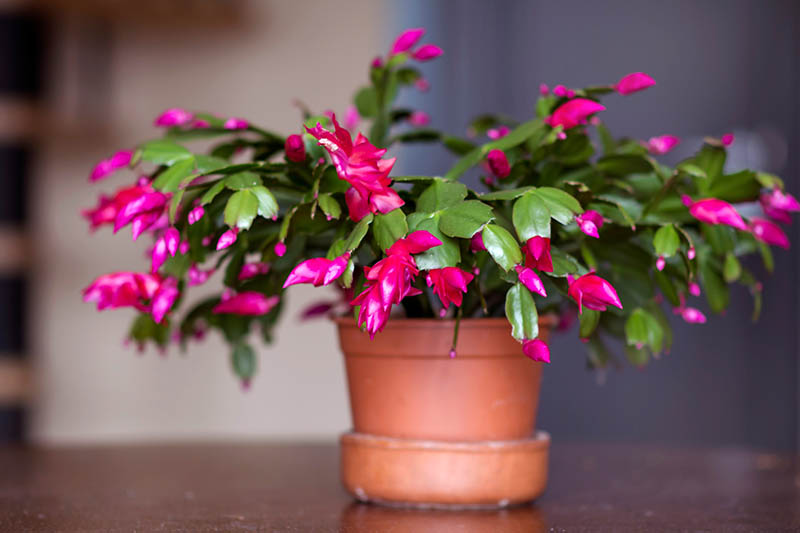Why Your Christmas Cactus Might Be Blooming in May
Christmas cacti are known for their vibrant flowers that bloom around the holiday season, typically in December. However, some Christmas cacti may bloom in May, which can be a surprise for many plant enthusiasts. So, why does this happen? The answer lies in the plant’s natural response to its environment.
Temperature is one of the primary factors that affect Christmas cactus blooming. These plants typically thrive in temperatures between 60°F to 70°F (15°C to 21°C). If the temperature is too high or too low, it can disrupt the plant’s natural blooming cycle, causing it to bloom in May instead of December. For example, if the plant is exposed to warmer temperatures during the spring, it may produce flowers earlier than expected.
Light is another crucial factor that influences Christmas cactus blooming. These plants require a period of darkness to induce flowering. If the plant is exposed to too much light, especially during the spring and summer months, it may not produce flowers. On the other hand, if the plant receives insufficient light, it may bloom in May instead of December.
Watering is also an essential factor that affects Christmas cactus blooming. Over-watering can cause the plant to focus its energy on producing new growth instead of flowers. Under-watering, on the other hand, can stress the plant, leading to premature blooming. It’s essential to maintain a consistent watering schedule to promote healthy growth and blooming.
In some cases, Christmas cacti may bloom in May due to their natural growth cycle. These plants typically produce flowers in response to the shortening of daylight hours and the cooler temperatures of fall. However, if the plant is not exposed to these conditions, it may bloom in May instead.
It’s worth noting that Christmas cacti are sensitive to their environment, and even small changes can affect their blooming cycle. By understanding the factors that influence blooming, you can take steps to encourage your Christmas cactus to bloom on schedule. In the next section, we’ll explore some tips and tricks to promote healthy growth and blooming in your Christmas cactus.
How to Encourage Your Christmas Cactus to Bloom on Schedule
To encourage your Christmas cactus to bloom in December, it’s essential to provide the right environment and care. One of the most critical factors is simulating natural daylight and temperature fluctuations. Christmas cacti typically bloom in response to the shortening of daylight hours and the cooler temperatures of fall. To replicate this, you can place your Christmas cactus in a spot with bright, indirect light and maintain a consistent temperature between 60°F to 70°F (15°C to 21°C) during the day.
Pruning is another crucial step in encouraging your Christmas cactus to bloom on schedule. Prune your Christmas cactus in the spring, after it has finished blooming, to maintain its shape and promote new growth. Remove any leggy segments, and cut back the tips of the stems to encourage branching. This will help the plant produce more flowers in the future.
Fertilizing is also essential for promoting healthy growth and blooming in Christmas cacti. Use a balanced, water-soluble fertilizer (20-20-20) during the growing season (spring and summer). Dilute the fertilizer to half the recommended strength to avoid burning the roots. You can also use a fertilizer specifically formulated for cacti and succulents, which will provide the necessary nutrients for blooming.
Repotting is another way to encourage your Christmas cactus to bloom on schedule. Christmas cacti typically need to be repotted every 2-3 years, as their roots can become pot-bound. Choose a well-draining potting mix and a pot that is only slightly larger than the previous one. This will help prevent the roots from becoming too wet and reduce the risk of root rot.
Finally, make sure to provide your Christmas cactus with a period of cooler temperatures (around 50°F to 60°F or 10°C to 15°C) for 30-60 days before you want it to bloom. This will help induce flowering and ensure that your Christmas cactus blooms on schedule.
By following these tips and providing the right environment and care, you can encourage your Christmas cactus to bloom in December, rather than in May. Remember to be patient, as it may take some time for your Christmas cactus to adjust to its new environment and start blooming on schedule.
Understanding the Life Cycle of a Christmas Cactus
Christmas cacti are popular holiday plants known for their vibrant flowers that bloom around the holiday season. However, to fully appreciate these plants, it’s essential to understand their life cycle and how they grow. A Christmas cactus’s life cycle consists of several stages, including germination, growth, and blooming.
The germination stage begins when a Christmas cactus seed is planted in well-draining soil. The seedling will emerge after 1-3 weeks and will require bright, indirect light and moderate watering. During this stage, the seedling will develop its root system and produce its first set of leaves.
As the seedling grows, it will enter the growth stage, during which it will produce new segments and roots. This stage can last several months to a few years, depending on the plant’s growing conditions. During this time, the Christmas cactus will require regular watering, fertilization, and pruning to maintain its shape and promote healthy growth.
When a Christmas cactus reaches maturity, it will enter the blooming stage. This typically occurs in the fall, around 30-60 days before the holiday season. During this time, the plant will produce flower buds that will eventually bloom into vibrant flowers. The blooming stage is the most critical stage of a Christmas cactus’s life cycle, as it requires specific growing conditions to produce flowers.
After the blooming stage, a Christmas cactus will enter a period of dormancy, during which it will require less water and fertilizer. This stage is essential for the plant’s survival, as it allows the Christmas cactus to conserve energy and prepare for the next growing season.
Understanding the life cycle of a Christmas cactus is crucial for providing the right care and environment for these plants. By recognizing the different stages of growth and development, you can adjust your care routine to promote healthy growth and blooming. In the next section, we’ll explore the role of light in triggering Christmas cactus blooming and how to provide the right light conditions for your plant.
The Role of Light in Christmas Cactus Blooming
Light is a crucial factor in triggering Christmas cactus blooming. These plants require a specific amount and type of light to produce flowers. In their natural habitat, Christmas cacti are exposed to bright, indirect light, which is essential for photosynthesis and flower production.
There are several types of light that can affect Christmas cactus blooming, including natural light, artificial light, and light intensity. Natural light is the most beneficial for Christmas cacti, as it provides the necessary spectrum and intensity for photosynthesis and flower production. However, if you’re growing your Christmas cactus indoors, you may need to supplement with artificial light.
Artificial light can be used to provide the necessary light spectrum and intensity for Christmas cactus blooming. Fluorescent lights, LED grow lights, and high-intensity discharge (HID) lights are all suitable options. However, it’s essential to choose a light that provides the correct spectrum and intensity for your Christmas cactus.
Light intensity is also critical for Christmas cactus blooming. These plants require bright, indirect light, but direct sunlight can be too intense and may cause burning. East- or west-facing windows are ideal for Christmas cacti, as they provide gentle, indirect light.
In addition to light intensity, the duration of light exposure is also important. Christmas cacti require a period of darkness to induce flowering. This is known as the “short-day” response, and it’s essential for triggering blooming. To promote blooming, provide your Christmas cactus with 10-12 hours of darkness per day, starting in the fall.
By understanding the role of light in Christmas cactus blooming, you can provide the necessary conditions for your plant to produce beautiful flowers. In the next section, we’ll explore the importance of watering and fertilizing for optimal blooming.
Watering and Fertilizing for Optimal Blooming
Watering and fertilizing are crucial for promoting healthy growth and blooming in Christmas cacti. These plants require careful watering and fertilization to thrive, especially during the blooming season. Over-watering can lead to root rot and other problems, while under-watering can cause the plant to become stressed and drop its buds.
To water your Christmas cactus correctly, make sure the soil is moist but not waterlogged. Watering once a week is usually sufficient, but this may vary depending on the humidity and temperature of your environment. It’s also essential to avoid getting water on the leaves or crown of the plant, as this can cause rot and other problems.
Fertilizing is also critical for promoting healthy growth and blooming in Christmas cacti. Use a balanced, water-soluble fertilizer (20-20-20) during the growing season (spring and summer). Dilute the fertilizer to half the recommended strength to avoid burning the roots. You can also use a fertilizer specifically formulated for cacti and succulents, which will provide the necessary nutrients for blooming.
It’s also essential to avoid over-fertilizing, as this can cause more harm than good. Christmas cacti don’t require a lot of fertilizer, and over-fertilizing can lead to weak and leggy growth. Instead, focus on providing a balanced fertilizer that will promote healthy growth and blooming.
In addition to watering and fertilizing, it’s also essential to provide your Christmas cactus with the right potting mix. Use a well-draining potting mix that is specifically designed for cacti and succulents. This will help prevent waterlogged soil and root rot, and promote healthy growth and blooming.
By following these tips and providing your Christmas cactus with the right watering and fertilizing conditions, you can promote healthy growth and blooming. In the next section, we’ll explore common mistakes to avoid when growing Christmas cacti, and how to correct them to promote healthy growth and blooming.
Common Mistakes to Avoid When Growing Christmas Cacti
While Christmas cacti are relatively easy to care for, there are several common mistakes that can prevent them from blooming. One of the most common mistakes is inadequate light. Christmas cacti require bright, indirect light to produce flowers, so make sure to place them in a spot that receives plenty of natural light.
Another common mistake is extreme temperatures. Christmas cacti prefer temperatures between 60-70°F (15-21°C) during the day and no lower than 55°F (13°C) at night. Avoid placing them near heating or cooling vents, fireplaces, or drafty windows.
Root bound conditions are also a common mistake that can prevent Christmas cacti from blooming. Christmas cacti prefer to be slightly root bound, but if the roots become too constricted, it can prevent the plant from producing flowers. Make sure to repot your Christmas cactus every 2-3 years to provide fresh soil and a larger pot.
Over-watering is another common mistake that can prevent Christmas cacti from blooming. Christmas cacti prefer dry soil, so make sure to water them sparingly. Watering once a week is usually sufficient, but this may vary depending on the humidity and temperature of your environment.
Finally, using too much fertilizer can also prevent Christmas cacti from blooming. Christmas cacti require a balanced fertilizer that is high in phosphorus to promote blooming. Avoid using too much fertilizer, as this can cause the plant to become leggy and prevent blooming.
By avoiding these common mistakes, you can help promote healthy growth and blooming in your Christmas cactus. In the next section, we’ll explore the importance of pruning and repotting for a healthy Christmas cactus.
Pruning and Repotting for a Healthy Christmas Cactus
Pruning and repotting are essential for maintaining the health and promoting blooming in Christmas cacti. Pruning helps to control the shape and size of the plant, while repotting provides fresh soil and a larger pot to accommodate the growing roots.
To prune your Christmas cactus, start by removing any dead or damaged segments. Cut back the tips of the stems to encourage branching and promote blooming. You can also prune the plant to maintain its shape and size, or to encourage new growth.
Repotting is also an essential part of caring for your Christmas cactus. Christmas cacti prefer to be slightly root bound, but if the roots become too constricted, it can prevent the plant from producing flowers. Repot your Christmas cactus every 2-3 years to provide fresh soil and a larger pot.
When repotting your Christmas cactus, choose a pot that is only slightly larger than the previous one. This will help prevent the soil from becoming too wet and reduce the risk of root rot. Use a well-draining potting mix that is specifically designed for cacti and succulents.
Here’s a step-by-step guide on how to repot your Christmas cactus:
1. Choose a pot that is only slightly larger than the previous one.
2. Use a well-draining potting mix that is specifically designed for cacti and succulents.
3. Water the plant thoroughly the day before repotting to make the soil easier to handle.
4. Remove the plant from its pot and gently loosen the roots.
5. Place the plant in its new pot and add fresh soil around the roots.
6. Water the plant thoroughly after repotting to settle the soil.
By pruning and repotting your Christmas cactus regularly, you can help maintain its health and promote blooming. In the next section, we’ll explore how to enjoy your late-blooming Christmas cactus.
Enjoying Your Late-Blooming Christmas Cactus
While Christmas cacti are typically associated with the holiday season, late-blooming varieties can still bring joy and beauty to your home. Instead of focusing on the timing of the blooms, consider the unique characteristics of your late-blooming Christmas cactus and how you can enjoy it.
One way to enjoy your late-blooming Christmas cactus is to display it in a decorative pot. Choose a pot that complements the colors and textures of the plant, and place it in a prominent location where you can admire its beauty. You can also add some decorative rocks or moss around the base of the plant to create a visually appealing display.
Another way to enjoy your late-blooming Christmas cactus is to share it with friends and family. Consider giving it as a gift to someone who appreciates unique and beautiful plants. You can also share photos of your plant on social media or with online plant communities to connect with other plant enthusiasts.
In addition to displaying and sharing your late-blooming Christmas cactus, you can also enjoy its blooms in other creative ways. For example, you can use the flowers to create a beautiful arrangement or centerpiece for your home. You can also press the flowers to create delicate, long-lasting specimens that you can use in crafts or as decorations.
Finally, consider the symbolism and meaning behind your late-blooming Christmas cactus. While it may not be blooming at the traditional time, it can still represent the hope and renewal that comes with the holiday season. You can also see it as a reminder to appreciate the unique and unexpected beauty that can be found in nature.
By embracing the unique characteristics of your late-blooming Christmas cactus, you can find new ways to enjoy and appreciate this beautiful plant. Whether you display it in a decorative pot, share it with friends and family, or use its blooms in creative ways, you can still experience the joy and beauty that this plant has to offer.


:max_bytes(150000):strip_icc()/Christmas-Cactus-GettyImages-171586548-5bbf92b0c9e77c005128e4a0.jpg)
